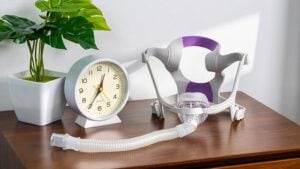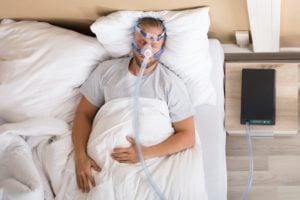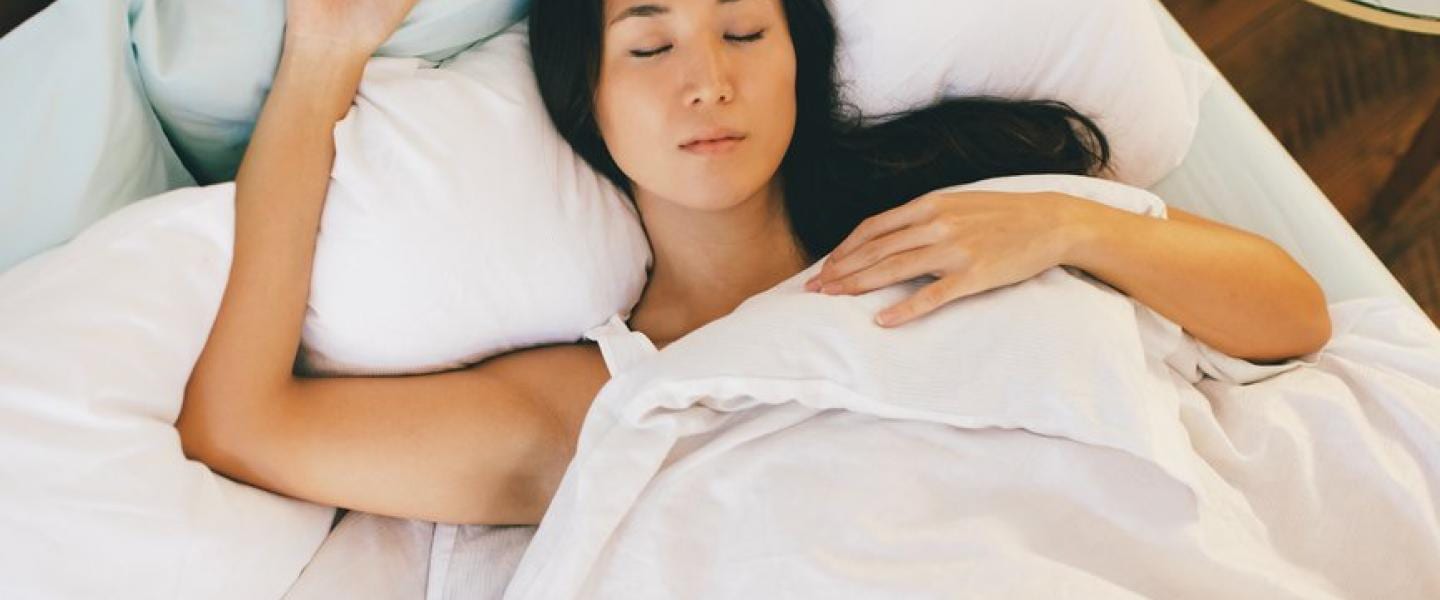When you buy through our links, we may earn a commission. Products or services may be offered by an affiliated entity. Learn more.
CPAP Mask Types
Continuous positive airway pressure (CPAP) therapy is one of the most common ways to reduce many of the symptoms associated with sleep apnea. CPAP therapy transports pressurized air to the sleeper’s breathing passages to help prevent airway collapse.
A CPAP machine produces the air and sends it through a hose that connects to a mask worn by the sleeper. This mask attaches to the user’s face to deliver the pressurized air through the nose, mouth, or both.
There are a few different types of CPAP masks available, and they all have their pros and cons. We’ll explain how each one works and who it’s best for. We’ll also discuss methods for increasing your comfort during CPAP therapy and what to keep in mind when choosing between the different types of CPAP masks.
What Is a CPAP Mask?
CPAP masks are devices designed to attach to a sleeper’s face during CPAP therapy. Though their look and feel can vary widely depending on style and brand, they’re generally made from silicone, gel, foam, or another type of flexible material.
Masks fit over or under the nose, mouth, or both. They’re most often clear, and manufacturers generally make them as low-profile as possible to ensure that they stay securely attached during sleep. The best CPAP masks are both comfortable and functional.
Each mask contains multiple components and attachments as part of its design. There are mechanisms to deliver the pressurized air, to attach the mask to the head, to create structure, and to keep the user as comfortable as possible. Each of these individual pieces has its own materials and lifespan to consider.
Most importantly, before purchasing a mask, you should ensure that it’s compatible with the type of CPAP machine you intend to use.
CPAP Mask Components
There are several CPAP mask components, and each one has a different function.
| Mask Headgear | Headgear keeps the mask securely attached to the user’s head. Magnetic clips and velcro are popular fasteners that allow for quick and easy detachment. You should replace your mask’s headgear or chinstrap about every six months or if you find you have to tighten it more than usual to get a suitable seal. |
| Mask Frame | The frame keeps all the other mask components attached and in place. The headgear and cushion connect to the frame, which is typically made from a pliable material that’s easy to wash. It’s important to keep the frame clean and to replace it every three months – or sooner if you notice wear and tear. |
| Mask Cushion | Your mask’s cushion is what seals around or beneath your mouth or nose. Cushions are usually made from flexible materials like silicone, gel, or foam. They attach to the mask’s frame and should rest comfortably against your face. Cleaning and replacing your mask cushion regularly helps prevent buildup from bacteria and mildew. Check with the manufacturer for a suggested replacement schedule or plan to purchase a new cushion every three months. |
| Mask Hosing | Pressurized air travels from your CPAP device, through your mask’s hosing, and to the cushion. This hosing is designed to flex and move with you as you sleep. If you notice that your hose is becoming opaque or developing tiny tears, you should purchase a replacement. Otherwise, plan on buying new hosing every three months. |
How CPAP Masks Reduce OSA Symptoms
People who have obstructive sleep apnea (OSA) may experience gasping, choking, or shallow breathing during sleep, as well as periods without breath. Untreated OSA can result in symptoms like drowsiness, irritability, and snoring, as well as health problems like cardiovascular disease.
These problems occur when a person has partial or complete airway collapse. CPAP therapy helps keep airways supported by pushing pressurized air into the user’s breathing passages. Mask cushions seal against the nose or mouth so that the air doesn’t leak out the sides. Many people with OSA find that CPAP therapy alleviates their symptoms and improves their sleep quality, which is why it’s considered the best treatment for the disorder.
Take Our Quiz to Know Your Sleep Apnea Risk
To understand if you could have sleep apnea, take our short quiz below to see if you exhibit any signs.
CPAP Mask Types
There are several different types of CPAP masks available today. The right one for you depends on many factors, including your face shape, sleeping position, pressure settings, and comfort.
Nasal Pillow CPAP Mask

CPAP nasal pillows have a low-profile design that fits between the user’s nose and upper lip. The pillow extends the full width of your nose and seals against your nostrils to provide a leak-proof fit. The hose connects to the pillow, and the entire unit is fairly small and unobtrusive.
Because this style of mask sits beneath the user’s nose, most people find that it’s easy to watch TV or read while wearing their mask. Nasal pillows have the most streamlined design and are often the easiest for users to tolerate.
- Who’s a Match for This Mask Type: People who shift sleeping positions often or those who think full-face masks are uncomfortable may have better luck with a nasal pillow. People with facial hair typically find that nasal pillows seal against their faces more effectively than other mask styles.
- Who’s Not a Good Fit for This Mask Type: Those who have high-pressure settings may want to choose another mask style, as this type may not be able to withstand significant pressure without leaking. Those with deviated septums or chronic congestion should also choose a different type.
Nasal CPAP Mask

Nasal CPAP masks cover either the entire nose or just the bottom half. This mask sits against the bridge of your nose like a pair of glasses and extends downward to your nostrils. The mask seals around your nose and pushes pressurized air into your nostrils.
This style mask has more volume than a nasal pillow but less than a full-face mask. Depending on where it attaches to the headgear, you may be able to see over top of your nasal mask to read or watch TV.
- Who’s a Match for This Mask Type: Back sleepers will likely find nasal masks an excellent choice. Side sleepers can also successfully use nasal masks, though they should ensure that their pillow doesn’t cause the mask to shift. Nasal masks are also a suitable option for those who find full-face masks uncomfortable and those with facial hair.
- Who’s Not a Good Fit for This Mask Type: This mask may not stay sealed if you sleep on your stomach. It can shift on the pillow and cause leaks, or it could come off entirely. It’s also not appropriate for mouth breathers or people with congestion problems.
Full-Face CPAP Mask

Full-face CPAP masks fit over your nose and mouth and seal against the bottom half of your face. This type of mask takes up the most surface area of all the mask types, and it’s typically within your field of vision. Unlike nasal masks and pillows, full-face masks can deliver air into your mouth, making this style the best option for people who breathe primarily through their mouths.
- Who’s a Match for This Mask Type: People who need high-pressure settings should consider using a full-face mask, as it’s better than the other two styles at staying securely attached with increased pressure. Those who breathe through their mouths may also find full-face masks beneficial.
- Who’s Not a Good Fit for This Mask Type: Active sleepers and those who can’t tolerate the size of a full-face mask should steer clear. People with facial hair and full beards may also need to opt for a different style, since full-face masks can’t seal properly against facial hair.
Less Common CPAP Mask Types
Though nasal masks, pillows, and full-face masks are the most popular mask styles, there are also a few other types of masks that CPAP therapy users can choose between.
Nasal Prong CPAP Masks
This type of mask is similar to a nasal pillow, but instead of sealing your nostrils, it uses nasal prongs, or cannulas, to deliver pressurized air. The mask sits underneath your nose, and prongs extend into your nostrils. These seal against your nostrils by inflating and creating air pressure.
This mask style is an excellent option for very active sleepers, as well as people with facial hair. Its very low profile makes it a good fit for those with claustrophobia, and its minimally invasive design may be easier to adhere to for some sleepers. However, people who need high-pressure PAP therapy should consider a different mask style.
Oral CPAP Masks
People who breathe through their mouth need a mask that seals over the mouth in order to get effective and consistent air pressure. Oral CPAP masks fit around just the mouth and are an alternative option for people who want a mask with less volume than a full-face mask.
This kind of mask doesn’t require headgear that fits across your forehead, making it a bit more comfortable for some sleepers than full-face masks. People who have allergies or frequent nasal congestion may find an oral CPAP mask the best choice.
Hybrid CPAP Masks
As the name implies, a hybrid CPAP mask uses two methods for delivering air. It seals under your nose as well as over your mouth, transporting air to both breathing passages. People who alternate between nose and mouth breathing may find this type of mask to be the best fit.
Hybrid masks are a bit smaller than traditional full-face masks and may be easier for users to tolerate. However, they’re not suitable for users with facial hair, and they may cause discomfort for people with congestion.
Total Face CPAP Masks
A total face CPAP mask covers your entire face, from above your eyes to below your mouth. This style mask is not necessary for most sleepers, but it can be very effective at preventing leaks for certain people. Even pressure is distributed into the mask, which can be more comfortable for people who are sensitive to high pressure.
This kind of mask has four points of contact with your headgear, and the whole surface area seals against your face. This can help prevent sore spots from developing, since the seal is distributed across more surface area.
CPAP Mask Accessories and Your Sleep Position
Wearing a CPAP mask can take some time to get used to, but there are many different accessories on the market that are designed to make therapy more comfortable.
Accessories for CPAP Masks
There are dozens of different CPAP accessories available to accompany your device, hose, and mask. Some are meant to help keep your mask clean, while others are designed to make your CPAP therapy more comfortable and effective.
- Mask Liners: Most CPAP masks and cushions are made from silicone, which can be irritating when placed directly on the skin. Mask liners are fabric barriers made from material that’s designed to feel softer than silicone. They’re often washable and engineered to keep your mask clean and hygienic.
- Chinstraps: CPAP chinstraps are designed for use with a nasal pillow or mask. People who use nasal options must keep their mouth closed in order to get effective CPAP therapy. Chinstraps wrap around or behind the head to keep the mouth closed. They’re made from many different materials that are each designed to feel comfortable against your skin.
- CPAP Pillows: There are different types and shapes of CPAP pillows, but they all have the same goal – to support your head and neck without interfering with your CPAP mask. They accomplish this with unique designs that feature cutouts or curves that accommodate your mask. Side and stomach sleepers can benefit from using a CPAP pillow.
Choosing a CPAP Mask Based on Your Sleep Position
Introducing a CPAP mask to your routine may make it trickier to sleep in your preferred position. Some masks and sleeping positions aren’t compatible, as your pillow or mattress can interfere with the mask’s fit, cause leaks, or even push the mask off your face entirely.
There are certain mask styles that are better suited to one sleeping position as opposed to another.
CPAP Mask Recommendations for Your Sleep Position
| Side Sleepers | Nasal pillows, masks, and prongs are all great picks for side sleepers, due to their lower-profile designs. However, some side sleepers may still find that their mask shifts when it hits their pillow. Using a CPAP-specific pillow can help prevent this from happening. |
| Back Sleepers | Back sleepers have the most options when it comes to picking a mask type. Regardless of which style they choose, it’s unlikely to come into contact with their pillow. Choose headgear that doesn’t fasten at the back to keep your mask as comfortable as possible. |
| Stomach Sleepers | Stomach sleepers can find it tricky to use a CPAP mask. They may develop pressure points where the mask and pillow touch each other, or they may experience leaks because their pillow pushes against their mask. This can also cause neck discomfort. A low-profile nasal pillow is the best option for stomach sleepers, though you should check if your pillow will interfere with your mask’s headgear and tubing. |
| Combination Sleepers | Combination and active sleepers may be happiest using a nasal mask or pillow, as these styles allow for an increased range of motion. They’re also less likely to leak than full-face masks because they don’t touch your pillow. Consider the sleeping positions you favor and choose headgear and a frame accordingly. |
Still have questions?
Our product experts have extensive experience testing just about every sleep product on the market. Send an email to [email protected] or call us at (877) 672-8966 with your questions and we’ll help you find exactly what you’re looking for.















